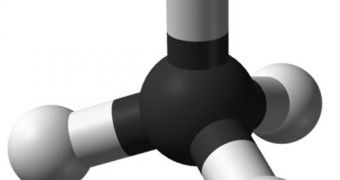In addition to carbon dioxide, the main gas held responsible for global warming, methane, is one of the most potent agents that can bring about climate change. Efforts of reducing emissions exist, but they are insufficient. To make matters worse, it has been recently confirmed that the gas escapes its Arctic sea-bed trap at an alarming rate. Its effects on the climate could be devastating, if efforts to reduce these amounts of released gas are not intensified, experts say, quoted by the BBC News.
In a new scientific study, it was determined that about 250 plumes of methane came out of the ground at locations in the sea bed off the coasts of Norway. The methane is released following a vicious cycle. As more and more CO2 is emitted into the atmosphere, the growing temperatures heat up the Arctic ices, melting them, and allowing the methane trapped between frozen water crystals to escape in the atmosphere. This, in turn, leads to even more heating, which continuously accelerates the release process, scientists believe.
According to the joint German and British research team analyzing the plumes off West Spitsbergen, the methane comes from depths ranging from 150 to 400 meters below sea level. Details of the team's investigations appear in the latest issue of the respected journal Geophysical Research Letters. Methane is usually stored under the waves in the form of methane hydrate, a compound that remains stable under high pressure conditions and low temperatures. More than 30 years ago, the hydrate was stable at depths of up to 360 meters, but now it would appear that the threshold has moved deeper, to about 400 meters, at the same location in the ocean.
“We already knew there was some methane hydrate in the ocean off Spitsbergen and that's an area where climate change is happening rather faster than just about anywhere else in the world. There's been an idea for a long time that if the oceans warm, methane might be released from hydrate beneath the sea floor and generate a positive greenhouse effect. What we're trying to do is to use lots of different techniques to assess whether this was something that was likely to happen in a relatively short time scale off Spitsbergen,” National Oceanography Centre in Southampton expert, Professor Tim Minshull says. The emissions were analyzed with a type of sonar normally used to search for shoals of fish.
“Our survey was designed to work out how much methane might be released by future ocean warming; we did not expect to discover such strong evidence that this process has already started.”
“We were slightly surprised that if there was so much methane rising why no one had seen it before. But I think the reason is that you have to be rather dedicated to spot it because these plumes are only perhaps 50m to 100m across,” the expert adds.
“The device we were using is only switched on during biological cruises. It's not normally used on geophysical or oceanographic cruises like ours. And of course you've got to monitor it 24 hours a day. In fact, we only spotted the phenomenon half way through our cruise. We decided to go back and take a closer look,” Minshull concludes.

 14 DAY TRIAL //
14 DAY TRIAL //